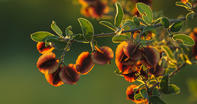
Name
Large-fruited bushwillow (Combretum zeyheri)Description
In comparison to other Combretum species, the bushwillow’s leaves are fairly large. This shrub is widely distributed and common. It reaches a height of up to 4 m and grows in deep and loamy sand.Large-fruited Bushwillow Flowers and Fruit
The bushwillow blooms during September in greenish-yellow axillary spikes. These sweet fragrant flowers have been seen to be in bloom during February and March, and it may therefore be possible that they bloom either for a prolonged period of time or twice a year. The fruits are usually four-winged and pale brown in colour, and stay on the branches of the shrub even after the leaves have fallen down.Where they are found
In South Africa, the large-fruited bushwillow can be found in its woodlands and savannahs.Large-fruited Bushwillow Uses
The large-fruited bushwillow has shallow growing roots which run 20 cm below the ground for 3 to 4 m and are a few millimeters thick. Women use the roots to make strong, ornamental baskets. These baskets were once used as plates, sealed with a plant paste, which made it waterproof.
The baskets were also used for carrying water, but today mainly for storage and sold for income. The unique designs are made by dyeing the roots beige, dark brown or grey, then weaving geometrical patterns into the basket. The roots are also used to make initiation necklaces for girls, and as a hair cosmetic.
The bark is burned and the ash boiled to for a resolution applied to the hair, straightening it and making it seem longer. Wild Seringa (Burkea Africana) is used to dye the roots grey, and the dark brown colour is from the bark of the kiaat tree (Pterocarpus angolensis).
This technique of dying and weaving is rare, and only a few Vasekele women are still able to practice it. The large fruited bushwillow is also used as medication for many ailments. To treat coughs, leaves are boiled and drunk three times per day.
To relieve stomach pain, roots are scraped clean, placed in a pot of water and heated slightly to be drunk three times a day. The roots, about as thick as a finger, are used to make toys such as bows for children. These toys do not break easily, and children can use them to practice bow and arrow. The root is not strong enough to make a bow of for real hunting, however.